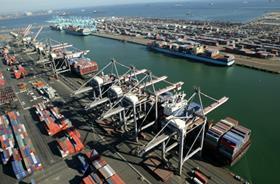
Six shipping carriers have become the inaugural participants in the Port of Los Angeles Environmental Ship Index (ESI), an international clean air programme that rewards ocean carriers for bringing their newest and cleanest vessels to the port.
Developed through the International Association of Ports & Harbors’ World Ports Climate Initiative, the ESI programme is the first of its kind in North America and the Pacific Rim, the Port of Los Angeles said in a press release.
Shipping carriers Evergreen, Hamburg Süd North America, Hapag-Lloyd, Maersk Line, Nippon Yusen Kaisha and Yang Ming have registered for the global programme and will begin receiving incentives later this year.
“We applaud these early adopters of the ESI program and encourage not only other carriers to participate but also other ports to join this global port program,” said Geraldine Knatz, executive director of the Port of Los Angeles.
“Growing participation among ports worldwide will increase the level of incentives available toship operators that invest in and deploy the cleanest, most efficient and environmentally friendly fleets.”
The web-based ESI programme, which is already underway at 14 European ports, offers immediate and significant clean air benefits by rewarding vessel operators for voluntary engine, fuel and technology enhancements that reduce emissions from ships beyond the regulatory environmental standards set by the International Maritime Organization (IMO).
The Port of Los Angeles said it developed its ESI with input from the Pacific Merchant Shipping Association and other stakeholders.
Its programme also conforms to the San Pedro Bay Clean Ports Air Action Plan, which sets specific bay-wide targets for near-term pollution reduction through 2014 and long-term objectives through 2023.
The Port of Los Angeles said its ESI programme is also an opportunity for vessel operators to get ahead of more stringent environmental requirements before they become mandatory.
On 1 January 2014, statewide clean air regulations will require ships operating within 24 nautical miles of the California coastline to use fuel with a reduced sulphur content limited to 0.1 per cent or less.
Under an Emissions Control Area established by international agreement, the same standard will take effect throughout North America on 1 January 2015.



